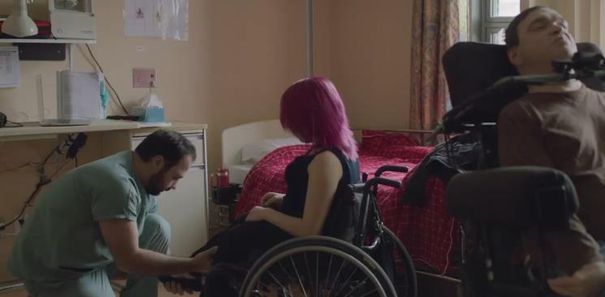Prends-moi
by Andra Petrescu

Directors Anaïs Barbeau-Lavalette and André Turpin came up with the idea for the short Prends-moi after learning that in some centers for disabled people there are types of intimacy rooms where patients can be helped to have intercourse. The film echos the Amercian Theraphy Session, in which Helen Hunt plays a sex-therapist who teaches a paraplegic man how to have sex in spite of his disability, but is different in style. While the American film concentrates very much on both characters, therapist and patient, and their personal development, the Canadian short focuses on the representation of bodies and sexuality, working with actors who have mobility problems in real life. The actress who plays the young woman is Maxime D. Pomerleau, a young woman who has been diagnosed with McCune-Albrigh syndrome; she works in web-journalism and as a dancer in a choreography group for impaired people. The actor is Alexandre Vallerand, who lives with cerebral paralysis, and has studied theater acting professionally.
Prends-moi shows a sensitive approach to the sexuality of physically disabled people choosing fiction over documentary, though at times touches the thin border between the two. The opening scene is distant and almost clinical, following a male nurse in what seems to be his daily routine: he moves a young paraplegic man, laying him to bed with the help of a clinical machine. This very technical chore finishes with the man lying naked on the bed, being pushed closer to another one where his girlfriend is already waiting for him, she too being physically disabled. As the male nurse leaves the room, the style of the film changes, becoming more intimate in the portrayal of their sexuality and possible challenges.
Though the camera does not show real sexual content, it does look at their naked bodies (the women has surgical scars on her legs) and their movements in a stylised manner which might have otherwise easily become exploitative or somehow abusive to the characters. The two directors use a few mechanisms to avoid this. Firstly, they don't aim to evoke empathy in the viewer, instead they prevent it. There is no place for feelings of compassion or sensuality in the sexual scenes, the beauty of them comes from the stylised cinematography through the way it uses the lighting. The viewer knows nothing about the characters beside their disabilities and their bodies in a moment of intimacy, allowing them to act and be seen as natural. However, it is important that the narrative chooses the male nurse as a protagonist, switching from his story line and perspective to theirs, starting and ending with him and his dilemma about how comfortable he feels about his job. This narrative device helps us acknowledge that assisted sexual acts might seem awkward, without representing the act itself as such.
And this is what makes the film interesting: its commitment to talk about how sexuality may be different for others.

